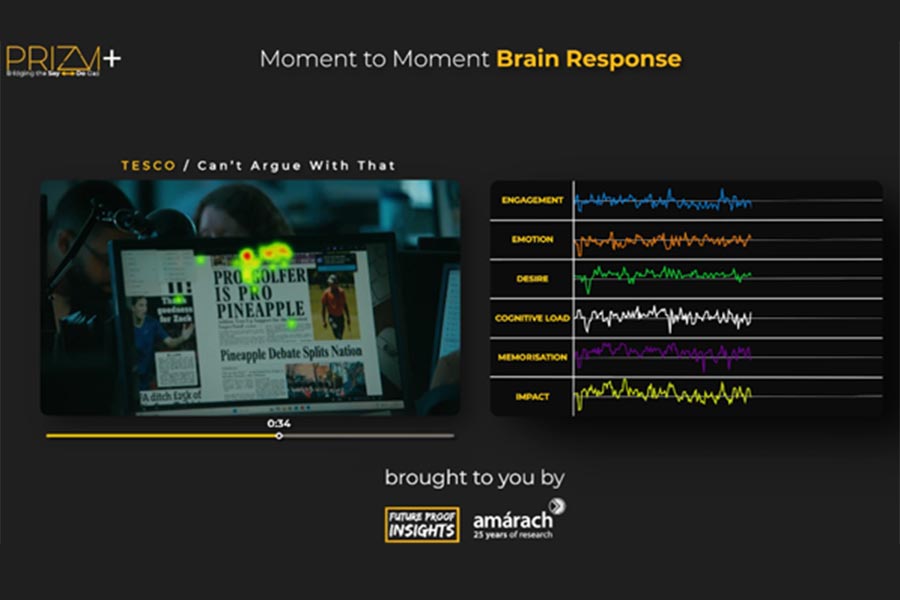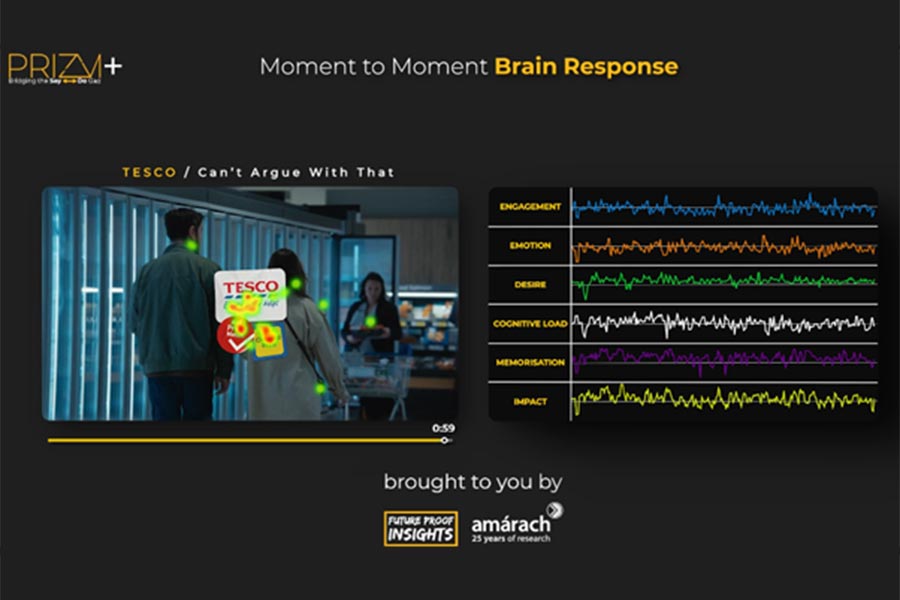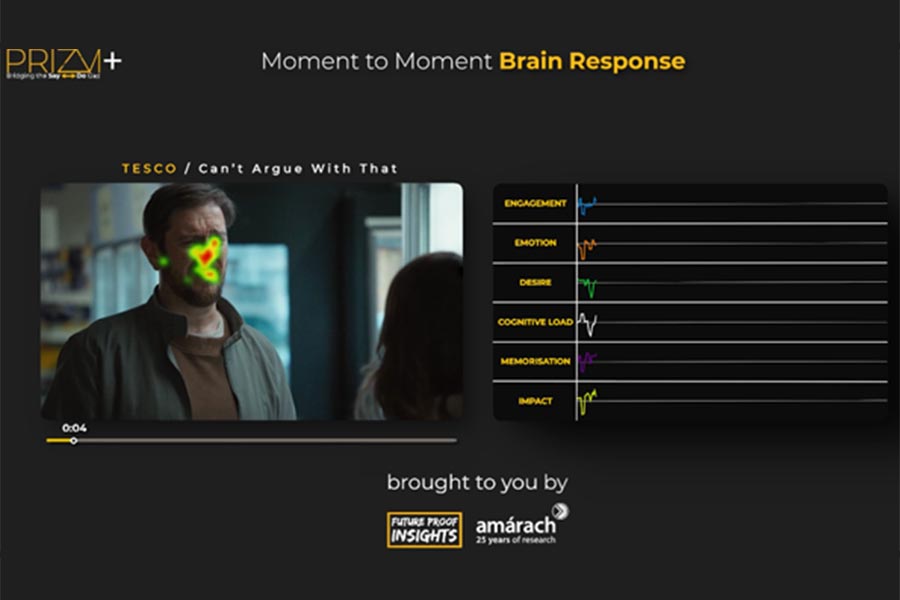Every week, Amárach and Future Proof Insights share exclusive findings from their PRIZM+ ad testing service, showcasing best practice creative advertising in Ireland.
Tesco’s latest campaign leans into a core principle of advertising: a relatable and universal concept.
In this case, the debate over whether pineapple belongs on pizza becomes the comedic centrepiece of a creative packed with micro-conflicts and deadpan resolution.
The stakes are trivial, but they're played out as though it's life and death, and that’s the point. Even the most divisive of public issues (the pineapple problem), can be resolved when Tesco's prices are this good (the solution).
This is comedy with a strategic purpose.
The ad uses humour, repetition and a highly choreographed escalation to create a conflict, that is rooted in a familiar anchor.
The problem is first presented in a retail context, and the resolution is tied to Clubcard Prices.
No lecturing. No logic leaps.
From an outcome perspective, this campaign scored very high for recall and distinctiveness, showing that the ad was not only entertaining, but the brand's role in the concept cut through.
Neural Performance Overview
Brain response data shows that the campaign builds steadily, with early scenes showing moderate engagement and emotion as the pineapple on pizza premise is framed to the viewer.
Crucially, this is very subtly framed in a retail environment, providing a very early anchor for the viewer about Tesco's category.
Those familiar with Tesco, will detect the slightly blurred brand cues around the clubcard prices over the male character's shoulder, this removes the need to spell it out for audiences, subtly implying the retailer in question in a very clever way.
But as the pineapple debate intensifies, so do neural responses.
Emotion, memorisation and engagement all lift as the social tension mounts, and as our characters battle it out for their side of the civil debate.
The dramatisation bordering on civil war, backed by Fat Boy Slim's "Right Here, Right Now" manages the tempo and pacing of the narrative very effectively.
The ultimate resolution of the conflict, and Tesco's role in it create clear payoffs that trigger clean spikes in memorability and impact.
From a Cognitive Load perspective, the ad does something very interesting, there's a high degree of scene switching that helps convey the level of debate across the population, which would normally trigger cognitive load as an audience would struggle to process.
However, the consistency in the narrative thread means the audience don't need to work to process the scenes, they understand the point, without needing to work too hard.
This generally keeps cognitive load within the optimal range throughout, confirming that the ad’s structure, complex in pacing but simple in message, keeps the viewer comfortably on board.
In short, the brain gets the concept and it sticks.
High Impact #1: Scene 4 (24.0s–42.0s)

We've focused in on a rapid-fire montage, rather than one individual scene here as it is the key vehicle in the dramatisation of the argument.
The montage throws us into the national argument: chefs, teens, journalists, nightclub goers, even newspaper headlines all weigh in on the pineapple debate.
Fatboy Slim’s “Right Here, Right Now” kicks in as the absurdity crests.
Visuals jump from club floors to front gardens, each character passionately defending or denouncing the fruit.
Why it worked: This is the ad’s emotional and narrative peak.
The tension builds now has the audience immersed, and the use of a well-known track adds pace to the emotional height.
The zealous nature of the way people are arguing triggers a relatability to the way other, more sensitive topics are played out in the public domain, between friends, neighbours and family.
Neural data confirms this is where the ad hits its rhythm, engagement improves, memorisation peaks, and cognitive load remains comfortably in range.
It’s chaos with structure, and the brain rewards that.
High Impact #2: Scene 6 (48.0s–60.0s)

After the storm, we return to where it all started: a man and woman in Tesco.
The man mutters, “It’s just wrong,” as the pineapple dispute still lingers.
But the store intercom interrupts, "Get great value Clubcard prices and Aldi price match…even on pineapples."
He pauses, then mutters: “Can’t argue with that.”
Why it worked: This is conceptual closure. The setup from earlier is paid off, the humour resolves into rationality, and it's Tesco delivering the solution, through their Clubcard.
Memorisation and impact perform solidly here, aided by the recency effect and narrative closure.
It’s not the most emotional moment, but strategically, it lands the brand message where it’s most likely to be remembered.
Underperforming #1: Scene 1 (0.0s–6.0s)

The ad opens with a shot from the side of the male character’s head.
He’s mid-sentence, facing away from the camera. From a neural point of view, this is a problem.
We know from social attention research that the human brain is especially sensitive to direct gaze and full facial visibility.
Faces presented in profile, or worse, partially obscured, fail to activate the fusiform face area with the same strength.
This weakens emotional resonance and disengages the viewer before the story even starts.
In this scene:
- Engagement, memorisation, and emotion all drop to their lowest point in the ad.
- The viewer is visually present but not socially or emotionally included.
- It’s only when the camera cuts to the woman holding the pineapple, facing forward, with a clearer emotional expression, that neural activity lifts.
From a storytelling perspective, the ad is asking us to tune in without giving us a human anchor.
From a brain perspective, it’s trying to start a conversation while we’re looking at the back of someone’s head.
Behavioural Impact: COM-B Insights
Motivation was the strongest behavioural driver, viewers clearly saw the value message and wanted in.
The use of humour and social proof (everyday people arguing) helped build reflective motivation without feeling like a sales pitch.
Capability also scored well.
The proposition is simple, consistent, and repeatedly reinforced: Clubcard Prices are great value...
Demographically, the ad landed best with younger adults and families who responded well to the humour and social tension.
Older audiences were less engaged, potentially due to lower relevance or genre fatigue.
- Younger adults (18–44) scored the ad higher across Motivation and Relevance. This group responded well to the humour, cultural references, and tone.
- Families with children also indexed high, likely due to the relatable conflict and household price sensitivity.
- Older audiences (55+) and those less price-sensitive showed weaker engagement and lower preference. The visual style and comedy pacing may have limited accessibility here.
This aligns with the ad’s observed neural profile: emotionally effective once the pattern sets in, but less immediately inclusive at the start.
Final Thought: Lessons for Marketers
This campaign offers several creative lessons for anyone working in retail or price-led advertising.
First, it shows how a retail environment can be used as a narrative context rather than just a backdrop.
By opening inside a Tesco store, the brand is already present, even before the first price is shown.
This grounds the story and subtly primes the viewer for a value message.
Second, the choice of music is more than just a stylistic cue.
The gradual build of “Right Here, Right Now” mirrors the narrative escalation, helping maintain emotional momentum across an otherwise disjointed montage.
It’s a cue the brain can follow even when the visuals shift quickly.
Third, the creative demonstrates how chaos can be consistent.
The pineapple debate spirals across people, places and tones, but the thread of absurd conflict holds it all together.
This repetition creates processing fluency, a cognitive effect that makes it easier for the brain to track the story and recall the message.
That said, the opening moment could work harder.
Starting on the side of a character’s head limits emotional entry and causes a measurable drop in attention and memory.
Earlier front-facing shots or emotional expressions could help draw the viewer in faster, setting the pattern, not just the scene.
This is a reminder that creative structure matters.
Set the frame. Build the rhythm. Anchor the message.
When those align, even the most trivial debate can deliver lasting brand impact.
For more insights from PRIZM+ on how neuroscience drives advertising impact, visit: https://www.futureproofinsights.ie/prizm-plus/









